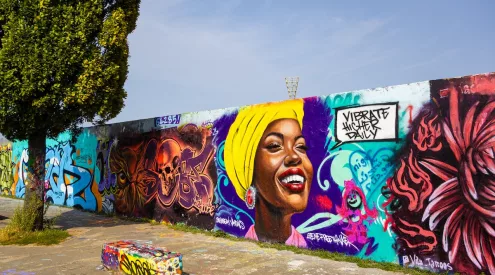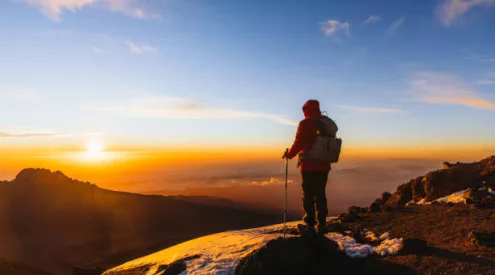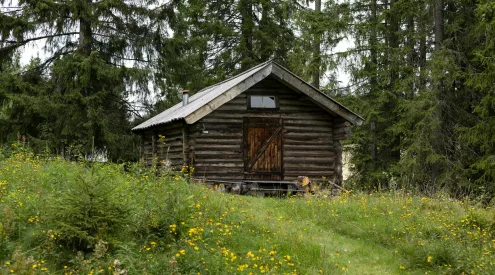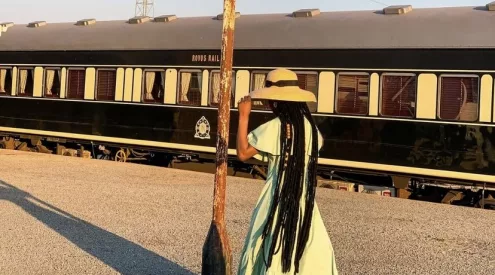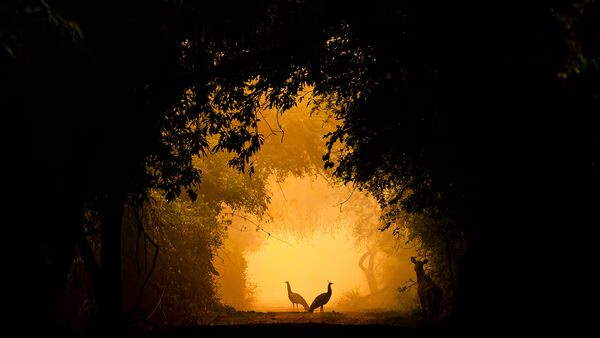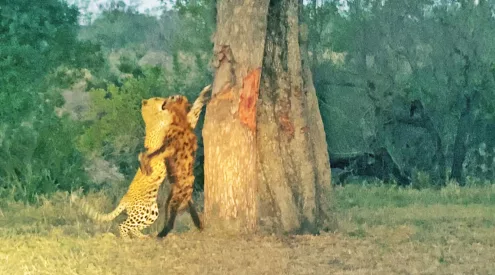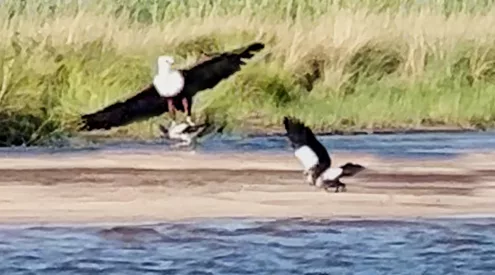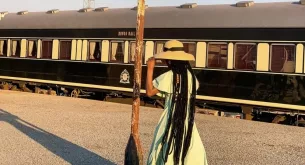When I came down off the mountain in Rwanda and plugged my camera into my laptop I was rewarded with an error message that read “˜corrupted files’. I’d potentially lost 212 pictures I had taken of the mountain gorillas. I thought about this for a while and it made me happy.
But more about that later “¦
A visit to Rwanda shouldn’t – in fact, can’t – be just about viewing gorillas and chimpanzees. I reckon that prior to 1994 a large chunk of the world’s population had never heard of Rwanda, or, if they had, wouldn’t have been able to pinpoint the tiny country on a map. Now, I’m pretty sure the majority of the planet’s inhabitants equate Rwanda with one thing – genocide.
However, Rwanda is a country that genuinely seems to be putting its past behind it. Forgive the cliché – it’s hard not to use them when describing this mind-boggling country – but it really is rising from the ashes.
The push to not only heal this troubled society, but to improve it, manifests itself in some odd but laudable ways. When we arrived at Kigali Airport the bureaucracy was complicated, in a typically African way, but the bureaucrats were friendly and I thought I’d practically sailed through the formalities until a man armed with a pair of scissors stopped me.
‘I’m sorry,’ he said, pointing to my plastic duty free shopping bag, ‘but plastic bags are not allowed in Rwanda.’
Yes, true. No plastic bags. Not a single one. Not only are they not given out or sold in supermarkets and other shops, you are not allowed to bring one into the country! The man’s scissors were for cutting off that anti-Joburg-airport-baggage-handler plastic cling film from your luggage, as that’s banned too.
Being made to pay for plastic bags, a la South Africa and parts of Australia, doesn’t stop them ending up in landfills or being scattered by the winds. Here is a country that has done the right thing, by banning them completely, but as I rode to our hotel in the hotel bus I thought; surely the government of Rwanda should be dedicating itself to more important legislation than banning plastic bags?
But then I thought, no “¦ this is exactly the sort of thing a government in charge of a fractured, wounded country should be doing. It’s a gesture that’s symbolic (i.e. about cleaning up and fresh starts and all that sort of stuff), practical, and easy to achieve, assuming a government has the balls to get serious about pollution. The first thing you notice driving around Rwanda is how clean it is compared to other African countries. And this in a country where the streets once ran, literally, with blood.
The drive for change is evident in more traditional ways, as well. There is construction going on all around Kigali, the roads are pretty good, and the foyer of the Hotel Des Mille Collines (aka the Hotel Rwanda as in the book and movie of the same name) hosts casual business meetings between prosperous looking locals and foreign businessmen and women.
Sadly, a visit to the Genocide Memorial, a museum and the resting place of 250,000 victims, is a must during a visit to Kigali.
Getting yourself understood in Rwanda can be bit difficult at times unless you happen to speak Kinyarwanda, as people tend to speak either limited English or limited French, or neither. Poignantly, the hotel concierge and the two drivers we organised to take us to the memorial all used the same shorthand word for it, ‘memory’.
Inside the building, which looked like a cross between colonial administrative offices and a rambling villa, the museum section documented and tried to explain the madness that gripped the country during the period of genocide and the reprisals that followed it. As confronting as the pictures and video of the atrocities, and even the skulls and clothing and photographs of some of the victims were, it was the grounds of “˜memory’ that shook me the most.
At first I thought the long, rather utilitarian looking concreted terraces I was looking at were old building foundations or some other relic of the site’s former use. But no, these were the caps of mass graves. Remains from the killing days are still being found and taken to the mass graves and on two of the terraces heavy steel sheets cover openings in the concrete. Bouquets of dried flowers rest on the covers.
Themed gardens talk of peace and harmony in diversity and all that kind of PC stuff, but my eyes were continually drawn back to those long concrete terraces, and the dried flowers. Industrial-scale burial for industrial-scale slaughter.
But we were there for the gorillas – the other thing Rwanda is known for. The next day we headed off into the hills in search of the really big hills of the Ruwenzori Mountains and the Volcanoes National Park.
Rwanda is nothing but hills. Sadly, every slope between Kigali and Ruhangeri, the nearest town to the national park, had been cleared and sculpted into terraces for farming. What little vegetation we did see was, ironically for us Aussies, gum trees.
We had hired two rather clapped out, but still functioning RAV 4s from a local tour operator for this part of the trip so we could self drive. While Kigali was predictably chaotic (with the added tension of driving on a different side of the road) the going through hills was remarkably easy and hassle-free.
Two hours after leaving Kigali we checked into the Kinigi Guest House, just a couple of hundred metres from the park entrance gate and when we ambled up to suss out the lay of the land and the starting time for our trek the next day we received a good briefing from the friendly guide on duty.
In another positive sign for Rwanda – and its famous wildlife – we learned that the latest census of mountain gorillas, carried out last year, found that the number of these magnificent creatures had increased 26.3 per cent since the last census, in 2003, to a current total of 786.
The gorillas live in two populations: about 300 in the Bwindi Impenetrable National Park in Uganda, and the remainder in the Virunga Massif, the string of dormant volcanoes that straddles Rwanda, Uganda and the DRC.
Of the 480-odd animals in the Virungas, 352 are habituated, with groups monitored on a daily basis. This means your chances of finding the gorillas on a trek are, if not guaranteed, pretty damned good.
We assembled at 7 am the next morning (‘”¦and I do mean 7 am sharp,’ the guide had told us the previous day, “none of this “˜7am Africa time’ stuff.”) along with scores of other tourists.
We’d first gone gorilla tracking in Bwindi, back in 1997 and I remember setting off with our guides and a couple of trackers armed with pangas, who scouted ahead of us for the troop we were looking for. Sure, they had a rough idea where the gorillas would be, but they still had to be found again each day. We slogged through the thick bush, mud, rain, and up and down hills for more than two hours to find our group – one of only two habituated groups in Bwindi at the time that were accessible to visitors.
By contrast, we soon learned that the national parks staff in Rwanda knew where all of the gorilla groups were, and how difficult each troop would be to get to. Gorilla families were assigned to the eagerly waiting visitors based on the age, mobility and fitness (of the tourists, not the gorillas).
Our assigned guide, Fidel, told us that we’d be tracking the Amahoro group, headed by a silverback named Ubumwe. Amahoro means peace in Kiyarwanda and Fidel further explained that while yesterday the group had numbered 14, today there were 15. There was a bit of air-punching among our little troop as we realised we might see a day-old gorilla.
From base camp we drove with Fidel, in our cars, along a progressively deteriorating road into the foothills of a towering dormant volcano. We passed banana trees and rows of beans and potatoes. When the RAV 4s could go no further we got out and walked, threading our way between a carpet of white daisies, laid out to dry on tarpaulins by the ladies who’d just picked them. Pyrethrum is extracted from the flowers to make insect repellent.
Fidel talked into his radio as we climbed over the low stone wall that marked the end of subsistence farming, and the start of a dense forest that covered a slope whose steepness had made it impossible even for terrace-loving Rwandans to farm. Habitat destruction has been the number one enemy of so many species, including the gorillas, who live in what amounts to an isolated chain of mountaintop islands in a sea of people and agriculture.
Our ascent was on a path made slippery by the previous afternoon’s rain and the daily traffic of trackers and tourists. It wasn’t easy, but nor was it nearly as difficult as our slog through virgin bush in Uganda 14 years earlier. A fresh pile of dung marked the nocturnal passage of a buffalo and as we climbed higher Fidel pointed out a springy woven nest of leaves and vines – a gorilla night nest, complete with another big pile of pooh, and some silver hairs.
‘The females and young make their nests in trees,’ Fidel explained, ‘but the silverback makes his on the ground, to guard against predators – and because he would fall out of a tree.’
Sweating and panting, we finally stopped climbing after about 45 minutes, and branched sideways on to a less defined track. In a small clearing Fidel had us remove our day packs and plant the wooden walking sticks we’d been issued with. A couple of us macho types had initially refused the offer of a walking stick at the base of the mountain, but Fidel had quietly insisted, and as it turned out we were glad he had.
‘Listen,’ Fidel said.
And there it was”¦ ‘Umh-haah’. That Sigourney Weaver (as Dian Fossey) two-part cough when she talks to the gorillas.
Fidel was joined by one of the two trackers who had been with the gorillas since just before dawn. These hard-working point men of the conservation and tourism effort in the Virungas stay with the habituated troops all day every day, not leaving them until the gorillas have made and settled into the night nests, just before dusk. Only then do the trackers come down the mountain, checking on their way for snares that might have been laid for other forest animals hunted for bush meat. The next morning the trackers are up when it’s still dark, and climb back up the volcano in time to meet the gorillas as they’re waking, and then follow them until the tourists arrive.
We followed the trackers and Fidel, trying unsuccessfully to avoid stinging nettles (long-sleeve shirts and long pants are a must, and Sigourney wears those chamois gloves in the movie for a good reason) and weaved our way along the fresh-cut trail.
And there they were.
Fidel pointed up and to the right of us and there was a female, sitting in a bushy tree just three or four metres away, with a youngster who lay on his back, arms spread, and with his head lolled back so he could stare back at us.
It’s hard to describe the feelings you experience when you first see the mountain gorillas. I went through that rush of emotions back in 1997 and, to be honest, it wasn’t the same this time. Back then there was adrenalin pumping through my veins, a mixture of elation at finding the troop, and perhaps a bit of primal fear at coming face to face with such an intimidating creature.
Of course, the gorillas meant us no harm, and the nerves gave way to fascination. My clearest recollection of my first encounter with a gorilla was that when I looked into its eyes they looked to all intents and purposes like the eyes of a human staring back at me from inside a gorilla costume. This wasn’t a lion or an elephant experience – this was something, someone, just like me.
I’m sure that if I’d had a mirror handy I would have seen that the slack-jawed awe that I’d felt on that first visit had been replaced this time with a broad grin. To see the gorillas again was, for me, like being reunited with a bunch of old friends you hadn’t seen for years. There was that instant connection, despite the fact that this was a different group in a different country.
I found that I felt relaxed and happy just being with them again, as opposed to trying to work them out, or worry what I should and shouldn’t be doing.
As for the gorillas, they didn’t care about us at all. As we stared at the female and her offspring a silverback male tramped down the path we’d just come down, weaving his way between startled humans, but otherwise ignoring us as though he was late for an important meeting. We’d been briefed that we would be kept seven metres away from the gorillas, but the gorillas clearly didn’t get that memo.
The gorilla who brushed past us was Kajoliti, who was, according to Fidel, the “˜deputy president’ of the Amahoro troop. The number one silverback, who we were yet to see, was Ubumwe. What was immediately noticeable about Kajoliti was that he was minus a hand.
Fidel had told us during the briefing that Kajoliti had lost his hand to a poacher’s snare, but the stump appeared to have healed well and didn’t seem to cause him a problem. He was, by all accounts, in fine fettle and apparently snuck off with one or another of the females whenever he could, while President Ubumwe was involved with important head silverback business.
Time and again over the next hour the gorillas passed between us, behind us, and in front of us, often within touching distance.
We, of course, weren’t allowed to touch the gorillas, but that didn’t stop a female from giving one of our member a firm but harmless slap on the bum while he turned to have his picture taken with the gorillas in the background. In another amusing moment a young male gorilla broke off a sapling and took a few swipes at one of the trackers – just for the fun of it, apparently.
The gorillas moved through the bush at a leisurely pace, tolerating us, and as the hour drew to a close we crept into a deeper, darker glade. There, sitting a few metres from us was the main man – Ubumwe.
I’d thought Kajoliti was a good sized silverback, but he was a midget compared to the president. It looked as though Ubumwe’s head alone was the side of my torso. He gave us a Mr T face, and returned to munching on his bamboo.
Something moved in the bush to Ubumwe’s left and we saw a tiny black face peeking around clump of leaves. The baby shyly hid himself again, as if playing peek-a-book with us. It wasn’t the newborn – he or she was suckling from its mother somewhere behind Ubumwe’s massive back, according to Fidel. But Umbumwe’s (or perhaps one-handed Kajoliti’s) second youngest continued to snatch glances at us and confound our fast firing camera shutters.
Then it was time to go.
In the time it’s taken me to write this blog I was able to borrow a memory card reader and recover the 212 corrupted pictures from my camera’s disk and now I’m a bit depressed.
You see, if I really had lost all those pics, as I first thought, I would have had a perfect visit to go back to Rwanda next year and see Ubumwe and Co again.
Sod it. I think I’ll go back anyway.

